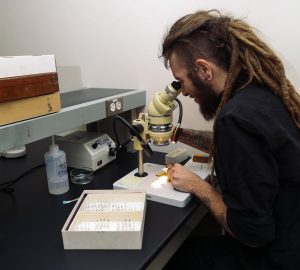For many researchers describing a new species seems like a tedious task. The differences between species might not be obvious, and the language confusing and foreign. This fact became apparent to me when I first presented my work to the Ant Lab at the Museum of Biological Diversity (MBD). As I described subtle differences in morphology, a little spine here and the shape of a hair there, I could tell that I had lost my audience by the dulled looks on my lab mates faces. How could they not see the differences in these two species?
“Some key differentiating characters: The integument is granulose, spatulate bi-colored setae occur between the frontal carina, the scape extends past the occipital corners. This is compared to a weakly irrorate integument, simple bi-colored setae between the frontal carina, and the scape reaching the occipital corners.”
 Fig. 2 – In case you are not familiar with the some terms used in describing ant species
Fig. 2 – In case you are not familiar with the some terms used in describing ant species
Totally clear, right?
While the differences in characters that separate Trachymyrmex new species and T. zeteki, are exciting for me, it seems to bore people to death. After my presentation, I received very helpful constructive criticism from my lab group. They thought it was interesting but a lot of my presentation went over their heads. My advisor, Dr. Rachelle Adams (Assistant Professor in the Department of Evolution, Ecology and Organismal Biology), encouraged me to find a way to turn the jargon into something people can digest and appreciate. I am still working on that, and it is a challenge many researchers face.
Species descriptions are important and a necessary part of daily life
Hopefully your parents told you when you were younger, never eat mushrooms you find in the woods. Taxonomy helps us understand what kind of mushroom you found, if it is edible, or if it might seriously hurt you if you eat it. Mushrooms are a great example of why taxonomy is important. Scientists need to describe and name species so that others can learn which characteristics define a species. Then chemists can tell us which are toxic. This information communicated to the public can potentially save lives! Taxonomists donate representations of species in museums so that they can be compared by other scientists in the future. Aside from publishing their species description, they submit the specimen used to describe the new species, a type specimen. Anyone who works with any type of animal or plant should be submitting voucher specimens, physical specimens that serve as a basis of study, as representatives of their work.
My Taxonomic Conundrum
While working on my species description, I reviewed all the literature that included T. zeteki. The 30 papers covered a number of areas such as fungus-growing ant genomes, mating systems, alarm pheromones, larvae development, and gut bacteria. Sadly, almost half of the papers do not mention depositing voucher specimens! Two articles deposited their DNA sequences as vouchers to a database for molecular data. Any research that uses DNA sequences has to submit DNA vouchers to that database; without it your work cannot get published. However, they do not have any physical vouchers linked to their sequences! This lack of physical vouchers was quite a surprise to me. The time I spent as an intern at the MBD Triplehorn Insect Collection, my advisors and other mentors strongly advocated the deposition of vouchers. Without being able to link your DNA sequence to a correctly identified organism, that DNA voucher loses its value. You cannot quickly identify an organism from DNA. Using morphology is the easiest way to do so! It seems many researchers don’t recognize the importance of vouchering and most non-taxonomic journals do not demand it. Research published without vouchers lacks reproducibility, an essential component of the scientific method.
In my research project, I am cleaning up the mess left behind from nearly twenty-years’ worth of poor vouchering and misidentification. I’m not only describing a new species and key characters that differentiate two cryptic species, I am listing all of the papers that have been published in the past twenty years using the names Trachymyrmex zeteki and Trachymyrmex cf. zeteki. By linking the new species description to these articles scientists can move forward knowing the proper identification of these hard-to-identify fungus-growing ants.
The deposition of vouchers should be required for all publications, and is crucial for, past, present, and future research in biology. In my undergraduate research, I discovered there is a disconnect between research museums like the MBD and many scientists. While I am still struggling to turn the technical jargon into information that can be swallowed by non-experts, there are discussions to be had about the importance of taxonomy as a cornerstone in biology.
If you want to learn more about fungus-growing ants and the importance of university research collections, come see us at the MBD Open House April 22, 10am – 4pm.
 About the Author: Cody R. Cardenas is a Senior Undergraduate student in Entomology working in the Adams Ant Lab.
About the Author: Cody R. Cardenas is a Senior Undergraduate student in Entomology working in the Adams Ant Lab.
*** We would like to hear from you – Please leave a comment ***

